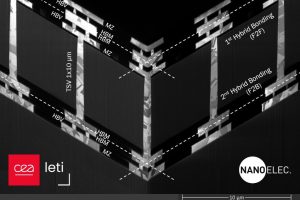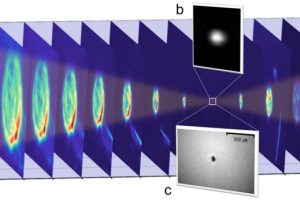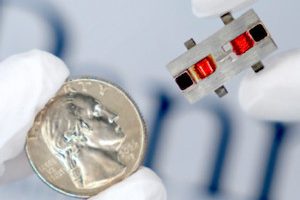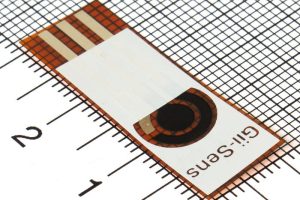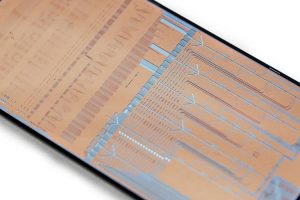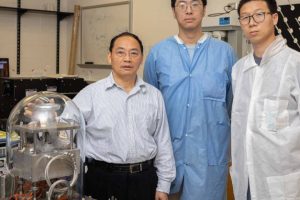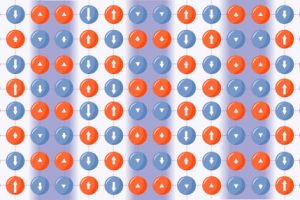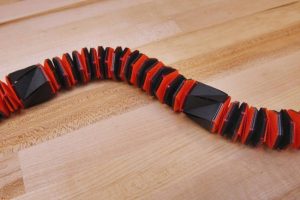French research lab CEA-Leti has reported stacking three 300mm wafers for improved CMOS image sensors, using hybrid wafer bonding and high-density through-silicon vias. The announcement was made in three papers at ECTC, the 2024 IEEE Electronic Components and Technology Conference in Colorado. 6μm hybrid bonding pad pitch, and TSVs are 1 x 10μm It is working towards a new generation ...
Research
The latest electronics research news from within the industry and universities from around the world.
Imec develops die-to-wafer bond process with 2µm pad pitch
Imec has developed a Cu-to-Cu and SiCN-to-SiCN die-to-wafer bonding process resulting in a Cu bond pad pitch of only 2µm at <350nm die-to-wafer overlay error, achieving good electrical yield. Such fine-grained die-to-wafer interconnects pave the way to logic/memory-on-logic and memory-on-memory applications. On the longer term, die-to-wafer bonding will enable also die- and wafer-level optical interconnects – for which imec demonstrated ...
Creating the post powerful THz pulse ever measured
Researchers in Korea have created the strongest ever terahertz electromagetic field: 260MV/cm or 9×1013W/cm2 equivalent peak – so powerful that it is classed as ionising radiation. A 150TW Ti:sapphire laser was used to convert optical energy into THz radiation in a 75mm magnesium oxide doped lithium niobate crystal wafer – a material with strong optical non-linearity and high damage threshold. ...
High linearity RF filter tunes over 3.4 to 11.1GHz
A University of Pennsylvania team has turned to yttrium iron garnet to build a non-volatile microwave filter than can be tuned across 3.4 to 11.1GHz. “What’s special about YIG is that it propagates a magnetic spin wave,” said research engineer Troy Olsson. The team is researching filters for 6G communication in ‘frequency range 3’ – FR3, 7 to 24GHz. “At these ...
Sensing lactic acid with a graphene-like foam capacitor
University of Bath researchers have created a lactic acid sensor using double-layer capacitance created when a particular sensitive molecule is attached to a graphene-like porous electrode structure and immersed in a buffer solution. Creating an ac-based capacitive sensor, as opposed to dc voltage or current based sensor, sides-steps concentration and chemical consumption issues encountered in battery-like reactions. The carbon material, ...
Chip analyses human white blood cells
Imec has teamed up with Sarcura, an Austrian start-up, to build an white blood cell analyser-on-a-chip using integrated photonics. Resolution is sufficient to discriminate between lymphocytes and monocytes, “rivaling the performance of commercial cytometers”, said Imec scientific director Niels Verellen. It is a flow cytometer and is based on the scattering of a laser beam though a sample. The intensities ...
Maths converges on a better thermoelectric material
A designer p-type thermoelectric material from the University of Houston has shown >10% conversion efficiency at a temperature difference of 475K. It is a high-entropy ‘Zintl’ alloy of the form YbxCa1-xMgyZn2-ySb2, for which the team devised a way to calculate the exact proportions by aiming for band convergence. “It is normally difficult to get high performance from thermoelectric materials because ...
How cuprate superconductors might work
Diagonal hopping by electrons explains superconductivity in cuprate ‘high-temperature’ superconductors, according to researchers associated with the Flatiron Institute in New York. The team used a straightforward two dimensional model, the Hubbard model, and hundreds of hours of supercomputer effort to get results that are close to those found in experiments. “There was tremendous excitement when cuprate superconductors were discovered, but ...
Quantum navigation components demonstrated in flight
A consortium has demonstrated quantum-based inertial navigation in an aircraft, the first such demonstration to be made public, according to the UK Government’s Department for Science, Innovation and Technology (DSIT). By using quantum-based references in the accelerometers and gyros at the heart of an intertial measurement unit (IMU), it is theoretically possible to maintain absolute accuracy over time as an ...
Origami brought to life for robot exploration
Seeking more ways to move a robot through complex environments, researchers at Princeton University and North Carolina State University have turned to origami animated by thermally-activated bi-material strips. The body of the snake-like structure is folded from flat sheet using a Kresling pattern, named after Biruta Kresling, an architect that created a number of such folded structures during bio-inspired research ...
 Electronics Weekly Electronics Design & Components Tech News
Electronics Weekly Electronics Design & Components Tech News
